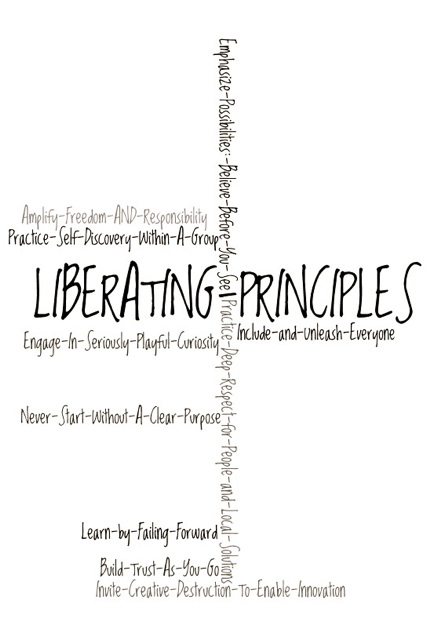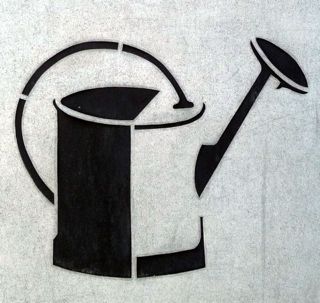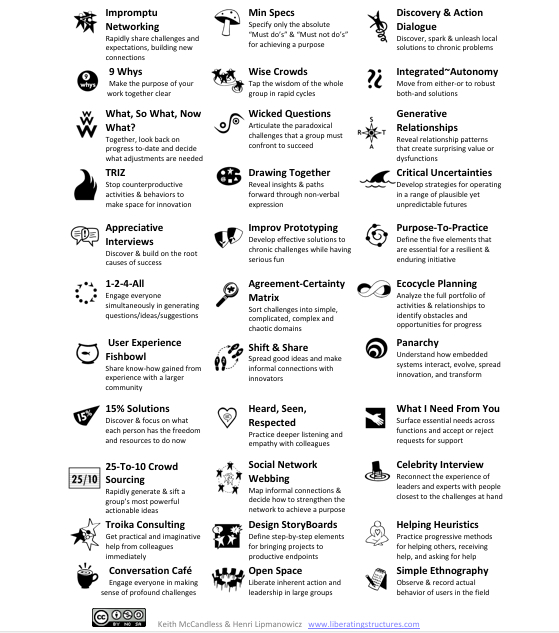 Microstructures & Design Elements
Microstructures & Design Elements
We are well aware that structures such as buildings and organizational policies and operating processes support and constrain our activities. We tend to be much less conscious of smaller structures that influence our interactions with other people. In contrast to more tangible macrostructures, we call them microstructures.
You have no choice. Every time you have a conversation or a meeting you are using microstructures.
The five most commonly used microstructures are presentations, open discussions, managed discussions, status reports, and brainstorming sessions.
Consciously or not, microstructures are the way you organize all your routine interactions. They guide and control how groups work together. They shape your conversations and meetings.
Microstructures enable and constrain what is possible.
Often, the familiar microstructures become frozen in routine and, in the process, become invisible. Operating on autopilot, we use the same microstructures over and over and easily loose sight of their role and influence. Their importance becomes immediately apparent when we start using a greater variety of microstructures like Liberating Structures. It forces us to be much clearer on our purpose in order to decide which one or which combination to use.
One simple way to become more mindful of microstructures is to identify their constituent elements.
Five elements define the underlying design of all microstructures—conventional or liberating. We call them design elements because you can make choices about them based on what you want to accomplish. The five design elements for a conventional presentation or lecture are illustrated below:
- a structuring invitation (listen to me);
- how the space is arranged and what materials are needed (rows or U facing presenter, screen, projector and PPT slides);
- how participation is distributed (nearly 100% of total time for presenter);
- how groups are configured (one group, one presenter); and,
- a sequence of steps and time allocation (presentation for most of time; possibly Q&A for balance of time).
Liberating Structures are designed with variations on these five structural elements. The elements are the minimum specifications (Min Specs) or essential foundation required to generate results with each Liberating Structure. Understanding this foundation helps you prepare when leading and facilitating with LS.
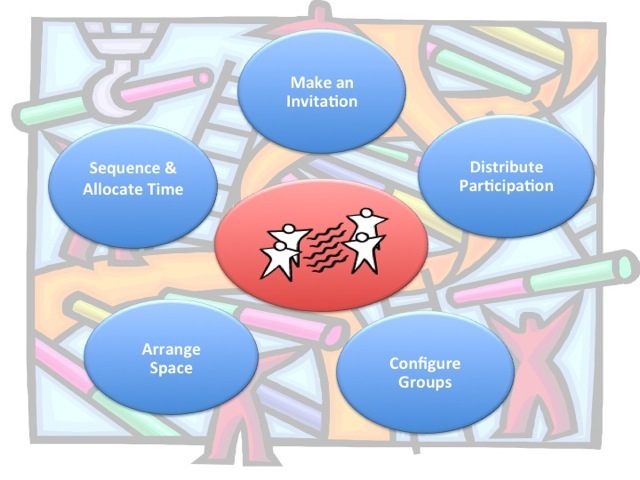 The five design elements of a microstructure
The five design elements of a microstructure
Microstructures introduce tiny shifts in how we meet, plan, decide and relate to each other.
LS can be chosen and implemented regardless of personal style, emotional intelligence, or charisma. In contrast to the typical story about leadership requiring a set of personal qualities that people are born with or need to develop through extensive training, you can use microstructures successfully if you are introverted and don't like to make eye contact.
Below is an example using the design of 1-2-4-All. When you are clear about each of the elements, using a Liberating Structure feels effortless.
1-2-4-All is designed to generate and sift many ideas from group members in rapid cycles. It is an alternative to brainstorming and status reports.
Structuring Invitation
- A question asking for ideas or proposals about an issue (e.g., What opportunities do YOU see for making progress on this challenge? How would you handle this situation? What ideas or actions do you recommend?)
How Paricitpation Is Distributed
- Everyone is given an equal time and opportunity to participate
How Groups Are Configured
- Individual
- Pairs
- Groups of four
- Whole group (in this order)
How Space Is Arranged and Materials Needed
- Small café tables with 4 chairs per table or groups of 4 chairs with no tables at all
- Notepads to record observations and insights
Sequence and Allocate Time Bells signal transitions in rapid cycle 1-2-4-All conversations
Bells signal transitions in rapid cycle 1-2-4-All conversations
- [1-2’] Silent self reflection on a shared challenge or issue (framed as a question)
- [2-5’] Generate and share ideas in pairs
- [2-5’] Share ideas from pairs in foursomes
- [5’] Each group shares one important idea with all and meanings/conclusions are recorded

In contrast to 1-2-4-All, the design elements of a presentation are illustrated below.
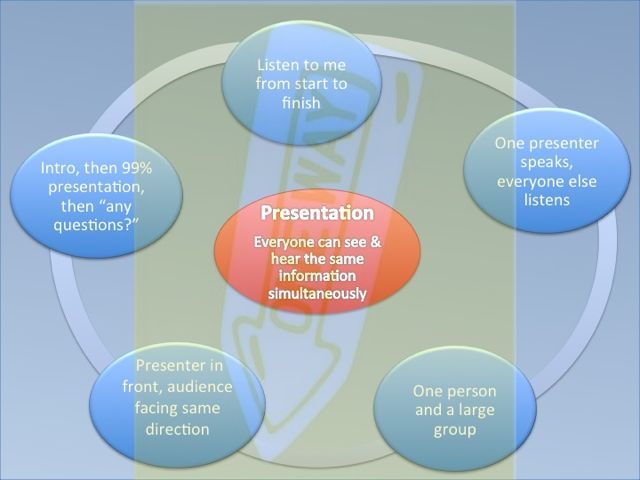
Key differences between Liberating Structures and conventional microstructures include:
- The Presentation puts maximum control of content in the hands of one person and has no structure to include/engage others.
- The Status Report is essentially like a series of presentations, putting the control of content into the hands of one person at a time and with no structure to include/engage others.
- The Managed Discussion puts into the hands of one person the control for including/engaging a small number of participants.
- The Brainstorm provides a structure to include/engage a few people in expressing their ideas without constraints.
- The Open Discussion has no control of content and no structure to include everybody.
Liberating Structures make it possible to include everybody regardless of group size and distribute the control of content among all participants.
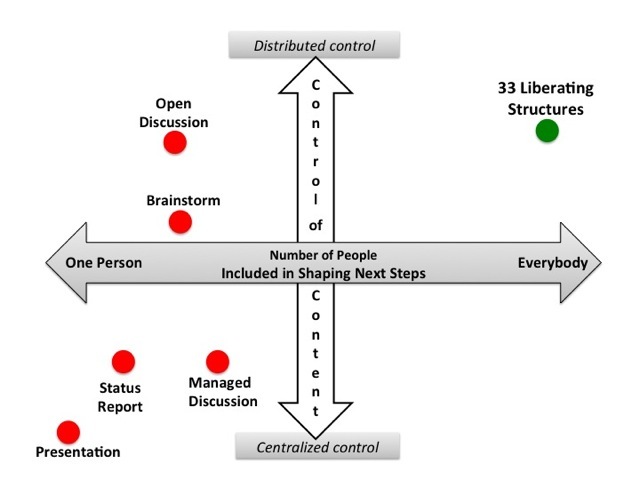 Liberating Structures and Conventional Microstructures Differences in Control and Structure
Liberating Structures and Conventional Microstructures Differences in Control and Structure
More about our discovery process as we began development work.
Liberating Structures: Simple, Subtle, Powerful from Liberating Structures on Vimeo.
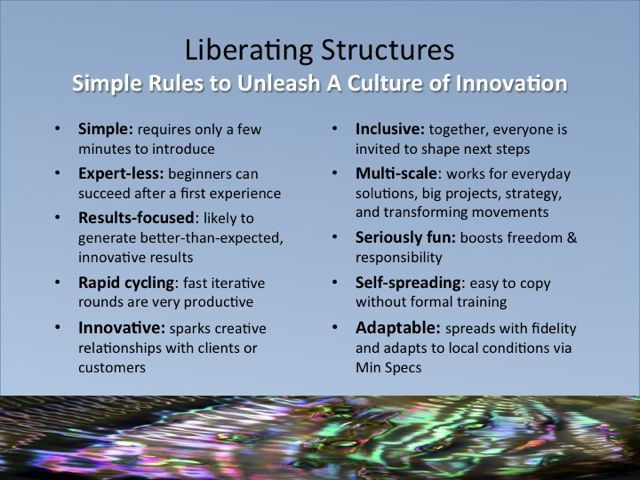 Key attributes of liberating microstructures. So tiny and modular they play very well with other approaches.
Key attributes of liberating microstructures. So tiny and modular they play very well with other approaches.
Menu of 33 Liberating Structures:
We want fewer possibilities that are more interesting!

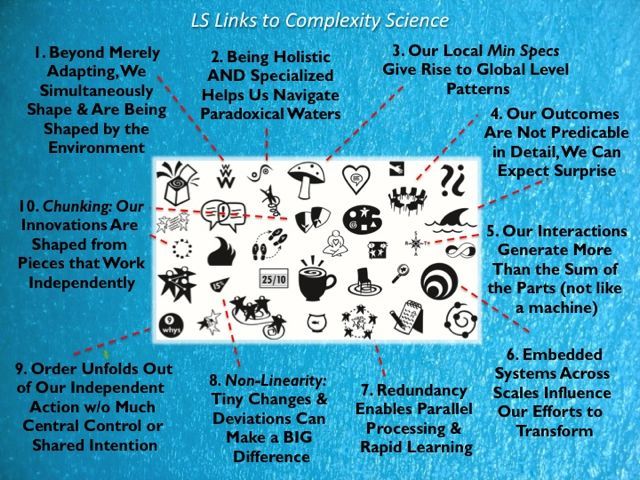
Complexity science insights inspired the design of specific Liberating Structures and the repertoire as a whole.
It is possible to overlook the power of Liberating Structures by focusing only on the individual methods or microstructures. They function as an interrelated set inspired by ten liberating principles. When we decide we belong together and will shape the future together, LS principles guide our behavior. Detailed descriptions here.